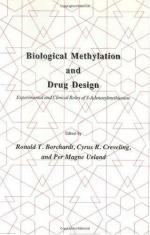|
This section contains 784 words (approx. 3 pages at 300 words per page) |

|
Addition of a methyl group (-CH3) to the DNA base, cytosine, creates a modified base called 5-methylcytosine, found in both prokaryotes and eukaryotes. This process is catalyzed by enzymes called methylases. In bacteria, methylation is part of a protective mechanism against foreign DNA. In mammalian cells, methylation of cytosine takes place specifically when it is located immediately 5' to a guanine, a structure called a CpG site; dense clusters of these sites are called CpG islands.
DNA, once methylated, tends to stay methylated through subsequent cell divisions, due to work of the maintenance methylase, DNA methyltransferase 1 (Dnmt 1). As DNA is replicated, it becomes transiently hemi-methylated, with methyl groups on the template strands but not the daughter strands. Dnmt 1 recognizes these structures and methylates CpG sites on daughter strands, thereby maintaining the methylation patterns.
Methylation is generally a silencing mechanism in mammalian cells, inhibiting transcriptional activity from the modified...
|
This section contains 784 words (approx. 3 pages at 300 words per page) |

|


